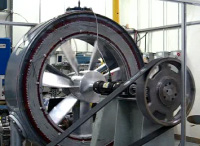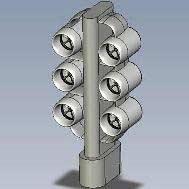For more than a century, the Mississippi River has been one of the nation's most-important transportation corridors, a muddy, winding pathway for moving bulk commodities such as grain and coal and other goods.
Now, a New England startup company wants to harness the mighty river for a secondary purpose — generating electricity.
The company, Free Flow Power Corp., is pursuing a $3 billion plan to install thousands of small electric turbines in the river bed, reaching from St. Louis to the Gulf of Mexico that would collectively generate 1,600 megawatts of electricity — enough to power 1.5 million homes.
Gloucester, Mass.-based Free Flow Power is one of a number of developers of so-called hydrokinetic projects, defined as those that produce electricity from river currents or ocean waves and tides — not dams.
Like the dozens of young companies building wind farms across the Great Plains or putting solar panels on roofs in California, interest in hydrokinetic projects is a response to a growing appetite for renewable energy as the nation tries to wean itself off crude oil and natural gas and reduce emissions of carbon dioxide, a heat-trapping gas linked to global warming.
"Necessity is the mother of invention, and what's really driving this is the need to develop alternatives to fossil fuels," said Daniel R. Irvin, 48, the company's chief executive.
Free Flow Power already has preliminary permits from the Federal Energy Regulatory Commission to study 59 sites on the river. Each site would consist of hundreds or thousands of turbines installed over a stretch of several miles, according to permit applications filed with FERC, which regulates most of the nation's hydropower projects.
The turbines, which would be attached to pilings in the river bed, are about two feet in diameter and probably would be made of carbon fiber or another lightweight composite material, Irvin said. The river's natural flow would spin the turbines to generate electricity, which would be transmitted to the power grid.
Free Flow Power chose the Mississippi River following a nationwide search in which it reviewed government data for 80,000 potential sites, looking for minimum average river flows of about 6.5 miles per hour. The sites between St. Louis and New Orleans were among the best they found and also are near electricity markets in the Midwest and Southeast, Irvin said.
The FERC permits give Free Flow Power three years to complete detailed environmental and technical studies as well as the first right to seek operating licenses for projects at those locations.
Irvin, a former investment banker, is hopeful the company can begin producing electricity as soon as 2012, though it may take five additional years to complete the build out.
To be sure, getting there won't be easy. The projects are likely to face close inspection by state and federal environmental regulators and the Army Corps of Engineers, which must assure the turbines don't interfere with river navigation. There's also the potential impact to fish and wildlife habitat, including the pallid sturgeon, an endangered species native to the Missouri and Mississippi river basins.
In January, an official with the Missouri Department of Conservation urged FERC to require an environmental impact statement on the "cumulative effects of proposed hydrokinetic power projects."
"The department has serious reservations regarding the installation and operation of hydrokinetic power within the Mississippi River," Janet Sternberg, a policy coordinator for the department, said in a letter to FERC. "Little information is available regarding the environmental impacts of a single project, or the cumulative environmental impacts from 14 projects that may affect more than 74 miles of the river."
Irvin said he expects scrutiny and has reached out to state and federal regulators. "With a public resource like a river, there are a lot of concerns that need to be addressed," he said.
Another hurdle is cost. Free Flow Power believes its projects can produce electricity at a price that's competitive with the output from natural-gas-fired plants.
"This is not as cheap as conventional hydro," Irvin said. "But we're working hard to make it comparable with fossil fuels."
Free Flow Power and other developers of hydrokinetic projects are hopeful to be included in legislation approved by the U.S. House of Representatives that makes production tax credits available to wind power developers. The measure would provide a tax credit per kilowatt hour that helps level the playing field with more-established generating technologies.
Free Flow Power sees scale as a key to its business plan to help hold down per-unit costs and improve economics.
"To try to do a one- to five-megawatt site or a bunch of smaller ones is pretty much setting yourself up for failure," Irvin said.
The so-called "in stream" hydrokinetic projects being pursued by Free Flow Power represent just one of several new technologies being developed to take advantage of untapped energy sources.
Virginia-based Verdant Power began testing underwater turbines, resembling the large wind turbines sprouting up across the Midwest, in New York City's East River off New York in late 2006 as part of the Roosevelt Island Tidal Energy Project. A larger commercial project is planned for Canada's St. Lawrence River.
Another company, Houston-based Hydro Green Energy LLC, also is pursuing projects in the Mississippi. Still others are developing technologies that would generate electricity from ocean waves and tides.
"There are some new technologies now that are being developed that we certainly haven't thought about before," said Linda Church Ciocci, executive director of the National Hydropower Association in Washington.
These new technologies are the product of rising prices for conventional fuels such as oil and natural gas that help make emerging technologies more viable as well as state and federal policies that encourage the use of cleaner renewable energy.
Proposed hydrokinetic projects are just part of the untapped potential for hydropower, according to a 2007 study by the Electric Power Research Institute.
According to the study, the United States has the resource potential to develop an additional 23,000 megawatts of hydropower by 2025, including 3,000 megawatts from new hydrokinetic technologies and 10,000 megawatts from ocean wave energy devices.

